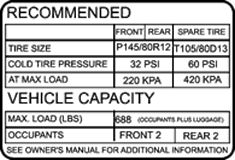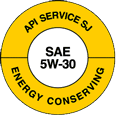Here are some tips to help you reduce the amount of gas you use. If you are already following these tips, you are probably getting the best gas mileage your car can deliver.
Drive more efficiently
Keep your car in shape
Plan & combining trips
Choose a more efficient vehicle
Drive more efficiently
Drive Sensibly Aggressive driving (speeding, rapid acceleration and braking) wastes gas. It can lower your gas mileage by 33 percent at highway speeds and by 5 percent around town. Sensible driving is also safer for you and others, so you may save more than gas money.
Aggressive driving (speeding, rapid acceleration and braking) wastes gas. It can lower your gas mileage by 33 percent at highway speeds and by 5 percent around town. Sensible driving is also safer for you and others, so you may save more than gas money.
Fuel Economy Benefit: 5-33%
Equivalent Gasoline Savings: $0.16-$1.06/gallon
Observe the Speed Limit While each vehicle reaches its optimal fuel economy at a different speed (or range of speeds), gas mileage usually decreases rapidly at speeds above 60 mph.
While each vehicle reaches its optimal fuel economy at a different speed (or range of speeds), gas mileage usually decreases rapidly at speeds above 60 mph.
As a rule of thumb, you can assume that each 5 mph you drive over 60 mph is like paying an additional $0.20 per gallon for gas. Observing the speed limit is also safer.
Fuel Economy Benefit: 7-23%
Equivalent Gasoline Savings: $0.23-$0.74/gallon
Remove Excess Weight
Avoid keeping unnecessary items in your vehicle, especially heavy ones. An extra 100 pounds in your vehicle could reduce your MPG by up to 2%. The reduction is based on the percentage of extra weight relative to the vehicle's weight and affects smaller vehicles more than larger ones.
Fuel Economy Benefit: 1-2%/100 lbs
Equivalent Gasoline Savings: $0.03-$0.06/gallon
Avoid Excessive Idling
Idling gets 0 miles per gallon. Cars with larger engines typically waste more gas at idle than do cars with smaller engines.
Use Cruise Control
Using cruise control on the highway helps you maintain a constant speed and, in most cases, will save gas.
Use Overdrive Gears
When you use overdrive gearing, your car's engine speed goes down. This saves gas and reduces engine wear.
Note: Cost savings are based on an assumed fuel price of $3.22/gallon.
Keeping Your Car In Good Shape
Keep Your Engine Properly Tuned
Vehicle engine diagramFixing a car that is noticeably out of tune or has failed an emissions test can improve its gas mileage by an average of 4 percent, though results vary based on the kind of repair and how well it is done.
Fixing a serious maintenance problem, such as a faulty oxygen sensor, can improve your mileage by as much as 40 percent.
Fuel Economy Benefit: 4%
Equivalent Gasoline Savings: $0.13/gallon
Check & Replace Air Filters Regularly
Replacing a clogged air filter can improve your car's gas mileage by as much as 10 percent. Your car's air filter keeps impurities from damaging the inside of your engine. Not only will replacing a dirty air filter save gas, it will protect your engine.
Fuel Economy Benefit: up to 10%
Equivalent Gasoline Savings: up to $0.32/gallon
Keep Tires Properly Inflated
Sample tire pressure label You can improve your gas mileage by around 3.3 percent by keeping your tires inflated to the proper pressure. Under-inflated tires can lower gas mileage by 0.4 percent for every 1 psi drop in pressure of all four tires. Properly inflated tires are safer and last longer.
Fuel Economy Benefit: up to 3%
Equivalent Gasoline Savings: up to $0.10/gallon
Use the Recommended Grade of Motor Oil
API energy conservation labelYou can improve your gas mileage by 1-2 percent by using the manufacturer's recommended grade of motor oil. For example, using 10W-30 motor oil in an engine designed to use 5W-30 can lower your gas mileage by 1-2 percent. Using 5W-30 in an engine designed for 5W-20 can lower your gas mileage by 1-1.5 percent. Also, look for motor oil that says "Energy Conserving" on the API performance symbol to be sure it contains friction-reducing additives.
Fuel Economy Benefit: 1-2%
Equivalent Gasoline Savings: $0.03-$0.06/gallon
Note: Cost savings are based on an assumed fuel price of $3.22/gallon.
Planning and combining trips
Combining errands into one trip saves you time and money. Several short trips taken from a cold start can use twice as much fuel as a longer multipurpose trip covering the same distance when the engine is warm. Trip planning ensures that traveling is done when the engine is warmed-up and efficient.With a little planning, you can avoid retracing your route and reduce the distance you travel as well. You'll not only save fuel, but also reduce wear and tear on your car.
Commuting
If you can stagger your work hours to avoid peak rush hours, you'll spend less time sitting in traffic and consume less fuel.If you own more than one vehicle, drive the one that gets the best gas mileage whenever possible.Consider telecommuting (working from home) if your employer permits it.Ride Share SignIf possible, take advantage of carpools and ride-share programs. You can cut your weekly fuel costs in half and save wear on your car if you take turns driving with other commuters. Many urban areas allow vehicles with multiple passengers to use special High Occupancy Vehicle (HOV) lanes.Consider using public transit if it is available and convenient for you.
Traveling
Car with loaded roof rackA roof rack or carrier provides additional cargo space and may allow you to meet your needs with a smaller car. However, a loaded roof rack can decrease your fuel economy by 5 percent. Reduce aerodynamic drag and improve your fuel economy by placing items inside the trunk whenever possible.Avoid carrying unneeded items, especially heavy ones. An extra 100 lbs in the trunk reduces a typical car's fuel economy by 1-2 percent.
Choosing a more efficient vehicle
Thinking about buying a new vehicle?Selecting which vehicle to purchase is the most important fuel economy decision you'll make.
The difference between a car that gets 20 MPG and one that gets 30 MPG amounts to $744 per year (assuming 15,000 miles of driving annually and a fuel cost of $2.97).
That's $3,720 extra in fuel costs over five years!
Download here the guideline and comparison 
Back to top
Source : fueleconomy.gov
Comments
Post a Comment